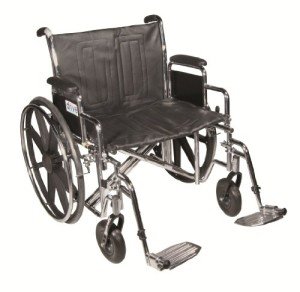Bariatric Wheelchair Seat Width
Seat Width
Having the correct seat width is important to wheelchair users who spend longer durations in their chairs. Too narrow a seat will trigger pressure on the hips and thighs which could lead to sores or pressure points. Having too large a seat can also make it tough for the user to reach the hand rims to move themselves or maneuver in little spaces.
To determine the appropriate seat width a person would sit on a chair usually and have their measurement taken across their lap at the widest point which is usually their hips. A wheelchair determining tape can be utilized to measure this, but a yard stick is chosen as it avoids individuals from covering the tape around their hips which would give an incorrect outcome.
The standard wheelchair seat width is 16" (narrow adult), 18" (standard grownup), and 20" (large grownup). For bariatric clients, a 24" seat is readily available. This heavy-duty extra broad bariatric wheelchair from Medline features swing-away footrests, a carbon steel frame with rust- and chip-resistant chrome plating, and easy-to-clean vinyl upholstery. It has a weight capacity of 500 pounds.
Seat Depth
Traditionally, the seat depth of a bariatric wheelchair was included 2" to the measurement taken at the user's widest point (normally their hips). This was implied to accommodate extra layers of clothing that may be worn during winter. However, this practice is becoming less common as wheelchair users have the ability to invest more time inside and are not wearing long coats. This makes the seat depth of a chair lesser when choosing a bariatric wheelchair. However, it is still important to select an option that offers appropriate assistance for bigger users.
The Medline folding extra large bariatric manual wheelchair includes a comfy 24" seat width and a sturdy slide tube silver vein frame. It also has an adjustable axle and tool-free elevating legrests.
Seat Height
When it pertains to determining the proper wheelchair seat width you ought to always measure from the user's largest point which is generally their hips. You will likewise require to consider whether the user is going to be wearing a winter season coat as this might include 2" to the width needed.

When a wheelchair remains in usage it ought to only be run on level surfaces with the wheel locks totally engaged. This is to prevent the chair from having the ability to move inclines that are 10 degrees or greater. It is also essential to keep in mind that any activity that might shift the center of mass in the chair must be finished with care. This consists of reaching for items that need the individual to lean out of their seat or trying to stand from it.
Whenever you have the chair in use it is advised that you routinely inspect it for damage and oil any locations that are deemed necessary. For example, the casters need to be lubed by removing the caster fork and using a multi-purpose grease to apply to the caster stem bearings. Also, the foot plates can be adjusted by loosening the bolt and after that moving them to the desired position. This allows the feet to sit comfortably on the footplate and prevents any pressure points from forming. bariatric wheelchair 600 lb capacity can be extremely unpleasant for the user and if left ignored, can lead to pressure sores.
Weight Capacity
Bariatric wheelchairs are developed to support more weight than standard wheelchairs. This makes them stronger and better equipped to handle falls. They are also usually larger and broader, making them less maneuverable in tight spaces than standard wheelchairs. They need cars with special ramps and lifts to load them, along with motorists who know how to best transport them from one area to the next.
When choosing a wheelchair, consider its weight capacity as it will be the main determining consider whether it will accommodate your guest's needs. The weight capacity of the chair is typically listed as a fixed load, suggesting that it shows the quantity of weight the chair can conveniently hold while stalling. However, some makers likewise note an active load that is based upon a drop test and can mimic the impact of somebody taking a seat in the chair. This may be a more trustworthy measurement of the weight limit, depending on your needs.
If you prepare to perform activities that move your center of gravity in the seat (such as grabbing items), be sure to have front casters pointed in a forward instructions and wheel locks engaged so the chair will not tip over. Likewise, inspect that casters are lubed regularly to avoid excessive wear and abrasions. The lubrication treatment involves getting rid of the fork, separating the caster from the wheel, and greasing the caster stem bearings with premium multi-purpose grease.
